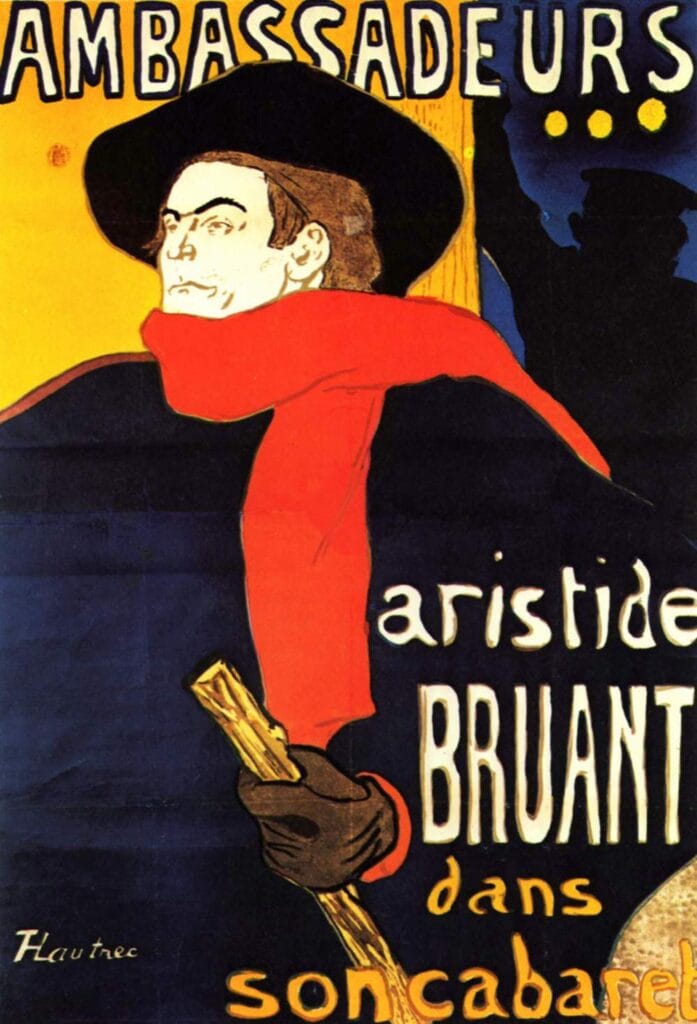Henri de Toulouse-Lautrec was a French painter and printmaker who, despite his short life, made an indelible mark on the world of art. Born in 1864, Toulouse-Lautrec was a key figure in the post-impressionist movement, contributing greatly to its development and evolution. His work is characterized by its bold colors, dynamic composition, and depictions of the Parisian nightlife. As an artist, Toulouse-Lautrec was unafraid to push boundaries and explore new techniques, making him a true innovator in his time. This blog post will delve into the life, art, and legacy of Toulouse-Lautrec, exploring the many facets of this fascinating and influential figure.

Early life and artistic influences
Born in Albi, France, Toulouse-Lautrec came from an aristocratic family with a long history of art patronage. His parents were first cousins, which may have contributed to his later physical and health issues. As a child, he suffered from several accidents that left him with a disability, stunting the growth of his legs and causing him to walk with a cane. Despite these challenges, Toulouse-Lautrec found solace in painting and drawing, developing a passion for art that would stay with him throughout his life.
Toulouse-Lautrec’s artistic education began when he moved to Paris at the age of 17. He studied under several prominent artists, including Fernand Cormon, who introduced him to the work of the impressionists. Toulouse-Lautrec was particularly drawn to the work of Edgar Degas, whose depictions of dancers and performers would greatly influence his own art. As a young artist, Toulouse-Lautrec also became fascinated with Japanese woodblock prints, which informed his use of bold lines and flat color.

Toulouse-Lautrec’s unique painting style
Toulouse-Lautrec’s painting style is characterized by its bold, expressive use of color and line. He often used vivid, non-naturalistic colors, such as bright reds, oranges, and yellows, to convey emotion and energy in his work. His compositions were often asymmetrical, with figures placed at unusual angles or cropped at the edges of the canvas. This sense of dynamism and movement was a hallmark of Toulouse-Lautrec’s work, reflecting his fascination with the bustling nightlife of Paris.
In addition to his unique use of color and composition, Toulouse-Lautrec was also known for his innovative techniques. He experimented with various mediums, including oil paints, pastels, and lithography. His work in lithography, in particular, was groundbreaking, as he was one of the first artists to use color lithography as a fine art medium. This allowed him to create vibrant, multi-colored prints that captured the energy and excitement of the Parisian cabaret scene.
Key themes and subjects in Toulouse-Lautrec’s art
Toulouse-Lautrec’s art is best known for its depictions of Parisian nightlife, particularly the cabaret and theater scenes. He was a regular patron of venues such as the Moulin Rouge, the Mirliton, and the Chat Noir, where he would sketch performers and patrons alike. His paintings and lithographs often featured dancers, singers, and actors, capturing the energy and excitement of their performances.
In addition to his fascination with the world of entertainment, Toulouse-Lautrec was also interested in the lives of those on the fringes of society. He frequently depicted prostitutes, both in their professional and private lives, offering a rare glimpse into the lives of these marginalized women. Toulouse-Lautrec’s art also touched on themes of loneliness and isolation, as seen in works such as “At the Moulin Rouge” and “The Medical Inspection.”

Toulouse-Lautrec’s impact on the post-impressionist movement
As a key figure in the post-impressionist movement, Toulouse-Lautrec had a significant impact on the development of modern art. His innovative techniques, particularly in the realm of lithography, helped to push the boundaries of what was considered possible in printmaking. His bold use of color and composition also influenced later artists, including the fauvists and expressionists, who would further develop these ideas in their own work.
Toulouse-Lautrec was also an important link between the impressionist and modernist movements. His work built upon the foundations laid by the impressionists, such as his use of loose brushwork and focus on capturing the atmosphere of a scene. However, he also pushed beyond these boundaries, embracing the more abstract and expressive qualities that would come to define modern art.
Famous masterpieces of Toulouse-Lautrec
Toulouse-Lautrec’s oeuvre includes numerous iconic works that have become synonymous with his name. Among his most famous paintings are “At the Moulin Rouge” (1892), “La Goulue at the Moulin Rouge” (1891), and “Jane Avril Leaving the Moulin Rouge” (1892). These works capture the vibrant energy of the Parisian cabaret scene, with their bold colors, dynamic compositions, and lively characters.
In addition to his paintings, Toulouse-Lautrec is also celebrated for his innovative lithographic posters, such as “Moulin Rouge: La Goulue” (1891) and “Divan Japonais” (1892). These works were instrumental in elevating the status of the poster as an art form, and their striking designs continue to be associated with the excitement and glamour of the Belle Époque.

Toulouse-Lautrec’s legacy in modern art
The influence of Toulouse-Lautrec’s work can be seen in the art of many subsequent artists and movements. His bold use of color and expressive line work can be traced through the fauvist movement, as seen in the work of Henri Matisse and André Derain. Likewise, his exploration of the lives of marginalized individuals and themes of isolation and loneliness can be seen in the work of expressionist artists such as Edvard Munch.
Toulouse-Lautrec’s innovative approach to lithography also had a lasting impact on the world of printmaking, paving the way for artists like Pablo Picasso and Marc Chagall to experiment with the medium. His posters, in particular, have become iconic symbols of the Belle Époque, and their vibrant designs continue to inspire contemporary artists and designers today.
Exploring Toulouse-Lautrec’s life through museums and exhibitions
For those interested in delving deeper into the life and work of Toulouse-Lautrec, there are several museums and exhibitions dedicated to his art. The Musée Toulouse-Lautrec in Albi, France, houses an extensive collection of his paintings, drawings, and lithographs, as well as personal items from his life. The museum is located in the Palais de la Berbie, a historic palace that offers a fitting backdrop for his work.
In addition to the Musée Toulouse-Lautrec, many major museums around the world, such as the Musée d’Orsay in Paris and the Metropolitan Museum of Art in New York, hold significant collections of Toulouse-Lautrec’s art. Temporary exhibitions are also frequently held, showcasing various aspects of his work and providing new insights into his life and legacy.

The continued fascination with Toulouse-Lautrec’s art
Toulouse-Lautrec’s art continues to captivate audiences today, over a century after his death. His bold, expressive style and unique subject matter have ensured that his work remains fresh and relevant, offering awindow into a bygone era and a glimpse into the lives of those on the fringes of society. Toulouse-Lautrec’s legacy is also evident in popular culture, as his posters and paintings have been reproduced and referenced in everything from advertisements to films.
There is something timeless about Toulouse-Lautrec’s art, something that speaks to the human experience and the desire to connect with others. His depictions of performers and outcasts are imbued with a sense of empathy and understanding, reminding us that everyone has a story to tell. His use of color and composition also speaks to a desire for joy and beauty, even in the midst of difficult circumstances.
Henri de Toulouse-Lautrec was a true original, a master of his craft who left an indelible mark on the world of art. His bold, expressive style and unique subject matter continue to captivate audiences today, offering a glimpse into the vibrant and exciting world of Belle Époque Paris. Through his paintings, lithographs, and posters, Toulouse-Lautrec was able to capture the essence of his time and offer a window into the lives of those on the fringes of society.
As we continue to explore and celebrate Toulouse-Lautrec’s life and legacy, we are reminded of the enduring power of art to connect us to each other and to the world around us. His work challenges us to see beauty and humanity in all its forms, and to embrace the vibrant, dynamic world around us. Whether viewed in a museum or reproduced on a poster, Toulouse-Lautrec’s art continues to inspire and delight, reminding us of the enduring power of the human spirit.











Great article. It always interests me to hear the influence of Japanese woodblock prints on painters.